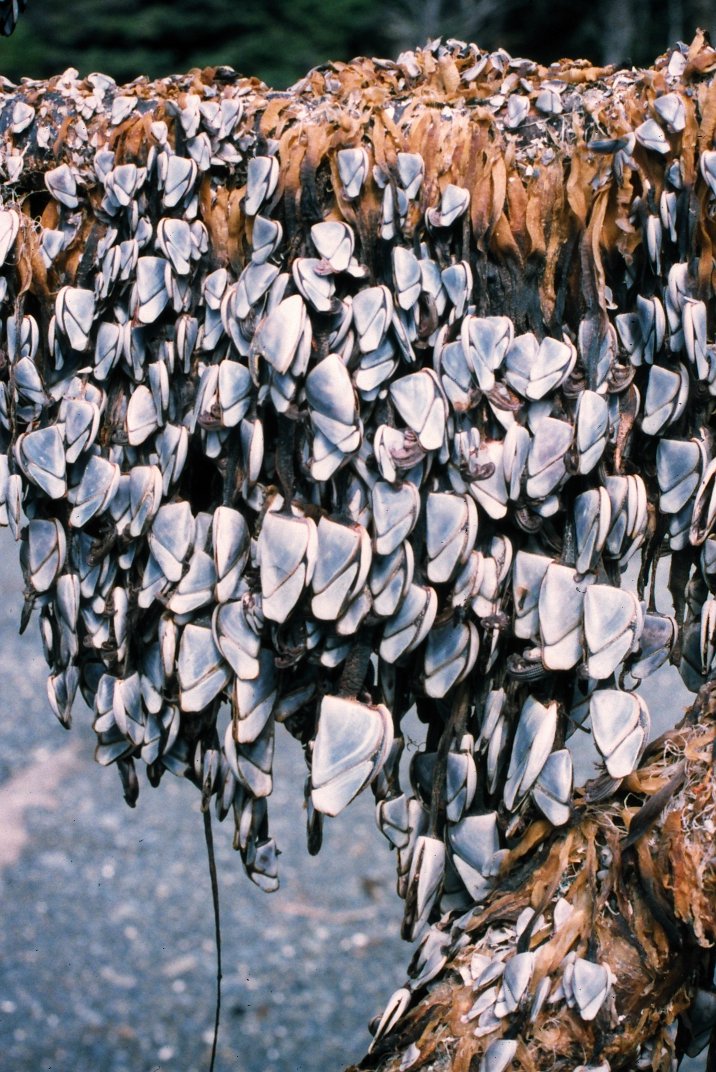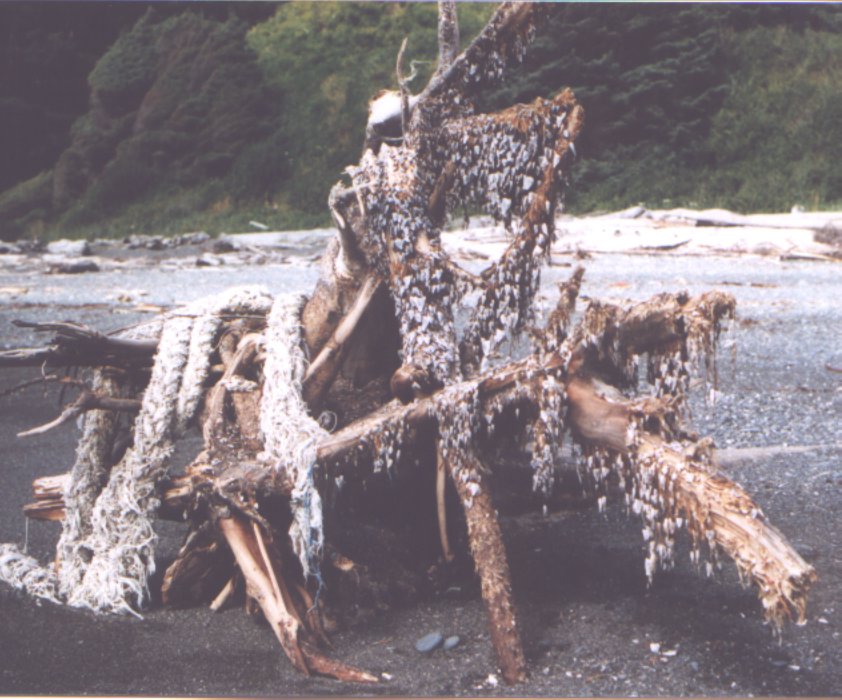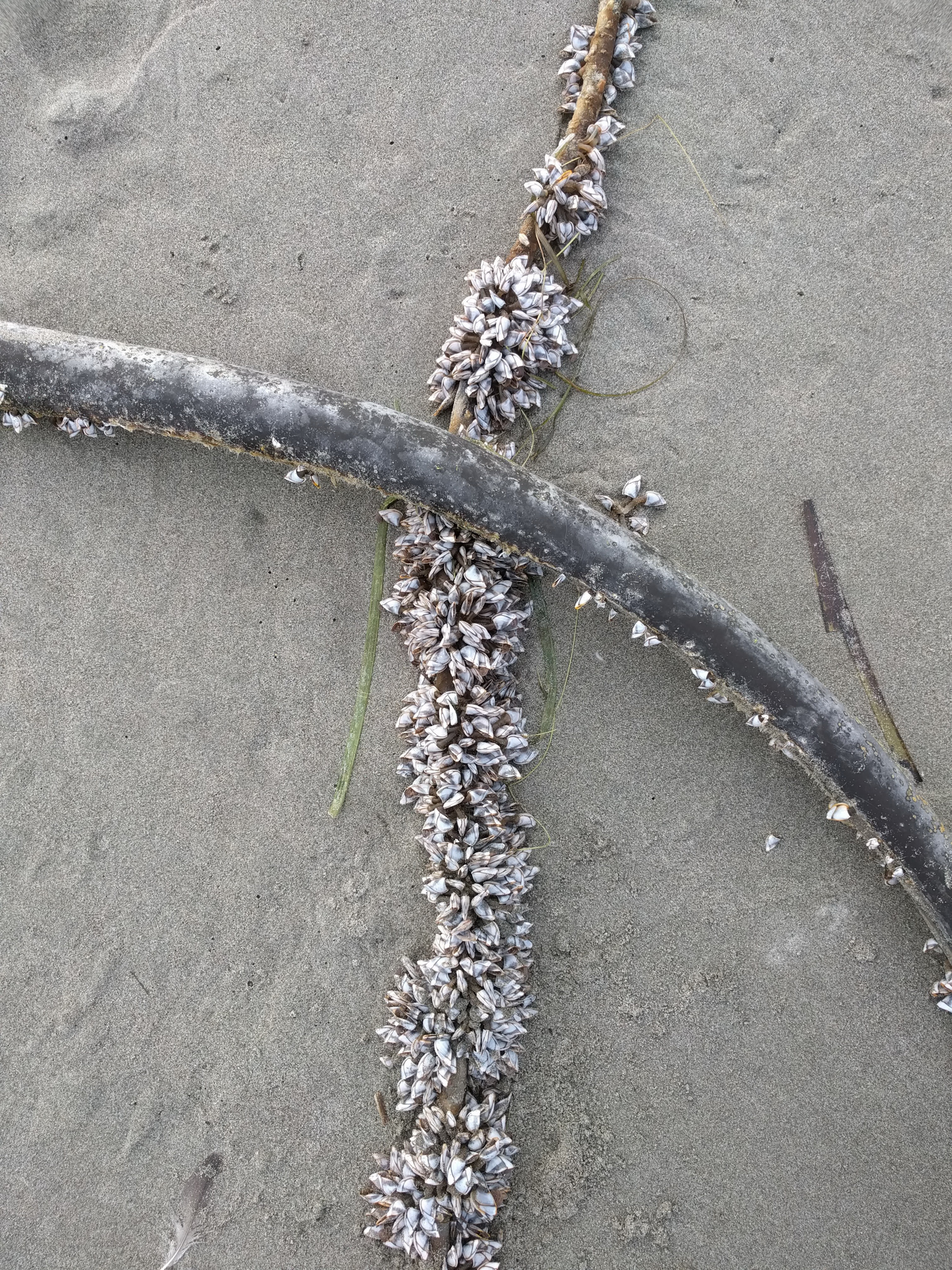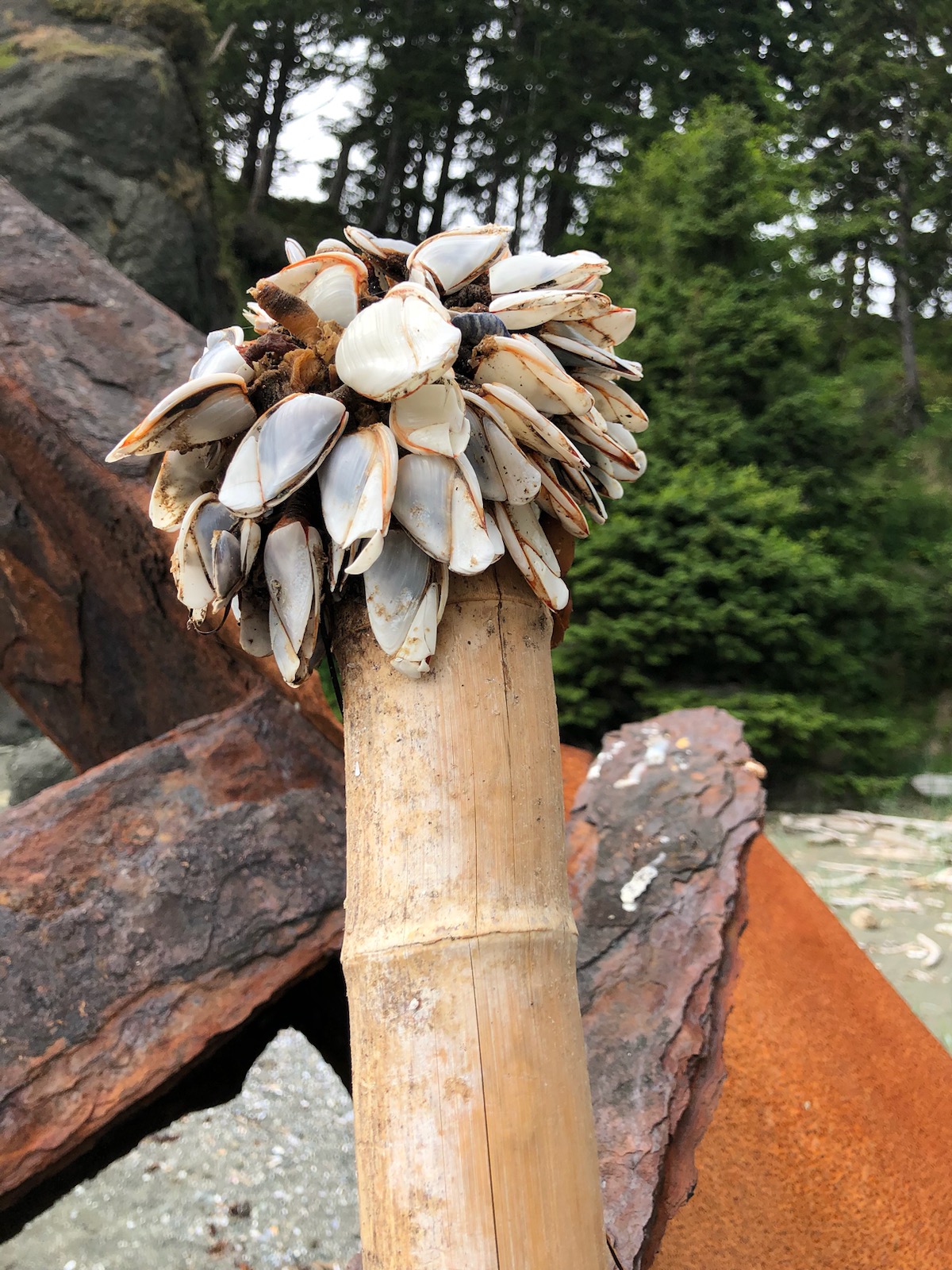Lepas anatifera Linnaeus, 1758Common name(s): Pelagic goosneck barnacle, Pelagic goose barnacle |
|
| Synonyms: |  |
| Phylum Arthropoda
Subphylum Crustacea Class Cirripedia Order Thoracica Suborder Lepadomorpha Family Lepadidae |
|
| Lepas anatifera on the roots of a driftwood log, Beach #4 near Kalaloch, WA | |
| (Photo by: Dave Cowles 7-1997) | |
How to Distinguish from Similar Species: Pollicipes polymerus, the other goosneck barnacle commonly found intertidally here in the Pacific Northwest, , has more than 10 plates in the capitulum and attaches to rocks. Lepas pacifica has a notch on the side of the capitulum that borders the scutum. Lepas hilli has smooth plates and 3 or more filamentous growths from the base of the first cirri.
Geographical Range: Cosmopolitan in the open sea (pelagic), especially in warm water. Often found attached to pelagic debris washed up on the beach on the open coast; on our shores not usually washed up south of Point Conception, CA.
Depth Range: Shallow pelagic, usually within a meter of the surface attached to a floating object.
Habitat: Pelagic, attached to floating wood and debris. Barreiros and Teves (2005) report finding a cluster of this species growing inside the mouth of a stranded Mola mola sunfish found in the Azores of the Atlantic, attached to its esophagus, and Magni et al. (2015) report L. anatifera attached to the clothing and shoes of a stranded corpse near Italy.
Biology/Natural History: This seems to be the most common pelagic gooseneck barnacle along the Washington coast. The opening of this barnacle is lined with beautiful scarlet tissue. The peduncle (stalk) is purplish-brown. Reaches sexual maturity when the capitulum is about 2.5 cm across. Fertilization is internal. Young are brooded in a mass attached to the mantle wall. Nauplii are released after about a week.
Mesaglio et al., (2021) studied this and several other species of Lepas in fouling communities off eastern Australia. They found that community diversity increases with time, that the δ18O content of the capitulum plates of L. anatifera and L. anserifera are a good proxy for seawater temperature (over a range of about 21.7 to 22.7 degrees), and that in these warm temperatures L. anserifera can grow between 1 and 1.5 mm capitulum length per day.
| Return to: | |||
| Main Page | Alphabetic Index | Systematic Index | Glossary |
References:
Dichotomous Keys:Kozloff 1987, 1996
Smith and Carlton, 1975
Flora and Fairbanks, 1966
General References:
Kozloff,
1993
McConnaughey
and McConnaughey, 1985
Morris
et al., 1980
O'Clair
and O'Clair, 1998
Niesen,
1994
Scientific Articles:
de Wolf, P., 2008. Very large goose-barnacles, Lepas anatifera L. 1758 (Cirripedia: Thoracica). Crustaceana 81(5): pp. 637-639.
Evans, F., Growth and maturity of the barnacles Lepas hilli and Lepas anatifera. Nature 182(4644): pp. 1245-1246
Jonker, J-I., J. von Byern, P. Flammang, W. Klepal, and A. M. Power, 2012. Unusual adhesive production system in the barnacle Lepas anatifera; an ultrastructural and histochemical investigation. Journal of Morphhology 273(12): pp 1377-1392
Macyntyre, R. J., 1966. Rapid growth in stalked barnacles. Nature 212: pp 637-638
Magni, Paola A., Cynthia Venn, Isabella Aquila, Francesco Pepe, Pietrantonio Ricci, Ciro de Nunzio, Francesca Ausania, and Ian R. Dadour, 2015. Evaluation of the floating time of a corpse found in a marine environment using the barnacle Lepas anatifera L. (Crustacea: Cirripedia: Pedunculata). Forensic Science International FSI-7818. 5 pages.
Mesaglio, Thomas P., Hayden T. Schilling, Lewis Adler, Shane T. Ahyong, Ben Maslen, and Ian M. Suthers, 2021. The ecology of Lepas-based biofouling communities on moored and drifting objects, with applications for marine forensic science. Marine Biology 168, article 21. https://doi.org/10.1007/s00227-021-03822-1
Memmi, M., 1982. Revision of the species Lepas anatifera (Crustacea, Cirripedia). Zoological Zhurnal 61: pp. 1165-1170
Patel, B., 1959. The influence of temperature on the reproduction and moulting of Lepas anatifera L. under laboratory conditions. Journal of the marine Biological Association 38: 589-597
General Notes and Observations: Locations, abundances, unusual behaviors:
This species can grow up to a very large size (The above specimen had stalks of up to 20 cm long).

Lepas is most frequently seen on
driftwood. Here is the
log the above specimens were attached to.
Photo by Dave Cowles at Beach #4, Olympic Peninsula, July 1997

Lepas is most commonly found on driftwood, but here is an example of the species attached to a Nereocystis kelp stipe. Photo by David Cowles near Astoria, OR.

This
cluster developed on the end of a stalk of bamboo drifting in the ocean
before washing up on shore. Photo by Dave Cowles, June 2023
Authors and Editors of Page:
Dave Cowles (2005): Created original page